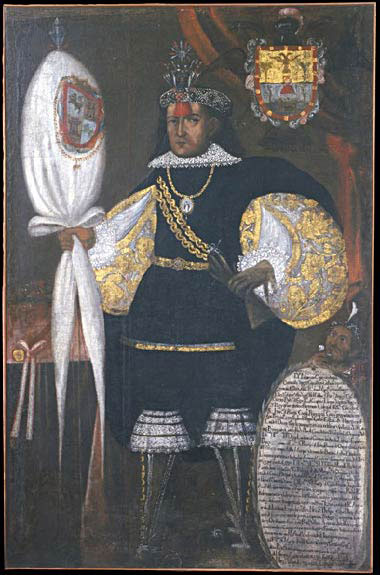guest chair / Denise Oleksijczuk, Simon Fraser University
Scholar and artist Denise Oleksijczuk’s training in art history and the fine arts has allowed her to fuse historical and theoretical analysis and visual observation. Her book The First Panoramas: Visions of British Imperialism (Minnesota UP) offers a subtle analysis of panorama paintings’ influential forms of imperialist storytelling and won the Historians of British Art Book Prize. Her current research explores art and activism, the environmental humanities, and Indigenous ecological philosophy. She is associate professor of Art, Performance and Cinema Studies at Simon Fraser University, Vancouver.

Portrait of Don Marcos Chiguan Thopa, c 1752. Cuzco, Peru, Museo Inka
D.9.1 Aesthetic (Moral) Agency and Two Portraits from Viceroyal Peru
Kimberly Aimée Alvarado, IDSVA
In this paper, I consider two portraits of Inca nobles during the viceroyal period of Peru (c. 1542-1821): one mid-eighteenth-century portrait of an Inca political figure and one early-seventeenth-century self-portrait by an Inca writer-illustrator. I will argue that an aesthetic language of an aristocratic portrait (visual composition, content, concept) parallels the creation of an ethical language by supposing an intelligible moral imperative that the portrait deploys in order to legitimize the sitter’s circumstances while exhorting a particular spectator (receptor) to honor the painting’s claims. In other words, the way the portrait looks seeks to exhort and convince the spectator to care for and regard (i.e. legitimize) the subject’s claim to authority. I will argue that the portraits of Don Marcos Chiguan Thopa (c. 1741-1752), the subject of the eighteenth-century portrait, and Don Felipe Guamán Poma de Ayala (1534-1615), the subject of the seventeenth-century self-portrait, embody an aesthetic (moral) agency that supposes a moral imperative that needs credibility. In other words, the portrait wants to convince a particular spectator of something, uses a particular aesthetic language to raise its capacity to be believed and urges a particular spectator’s ethical principles of conduct to do so. My main question is: could it be that a spectator’s belief in what is being signaled by the portrait is the answer to the code being sent? Is belief the moral currency being exchanged between portrait and spectator?
Kimberly Aimee Alvarado holds an M.A. in Art History from Queens College, CUNY and studied in the Art History doctoral program at The Graduate Center, CUNY. She is a Ph.D. student at the Institute for Doctoral Studies in the Visual Arts studying philosophy, aesthetics, and art theory. Her research focuses on otherness, race, and decoloniality in relation to hispanophone Caribbean art production, literature, and continental philosophy. She is a writer on the intersections of art, history, visual culture, race, philosophy, and ethics in relation to Latin American/Nuyorican studies and the Puerto Rican diaspora.
D.9.2 A Portrait of the Artist as a Worker: Piero Manzoni’s Merda d’artista in the Photographs of Giovanni Ricci
Tara Heffernan, University of Melbourne
Post-war Italian artist Piero Manzoni is remembered as a provocateur, famous for his shocking 1961 series Merda a’Artista (Artist’s Shit). Often celebrated as a rejoinder to the commercialisation of art, the series comprised ninety tin cans, their shape and size near identical to mass-produced tinned beef products, which purportedly contained the artist’s shit, Freshly Preserved, Produced and tinned, as promised by the label. Despite the heavy-handed reference to commercial mass-production, past analysis fails to acknowledge Manzoni’s pragmatic engagement with the very forms he is argued to critique – the world of advertising and mass-media. (These were, importantly, very new visual cultures propelled by the pervasive force of American media in the Marshall Plan era). Shot by Giovanni Ricci, a series of portraits featuring a sombre looking, hunched Manzoni in rumpled clothing alongside his Merda d’artista, were created as promotional material. Intriguingly, Manzoni seems bored by his own shit – the task of stacking and arranging the cans a tedious and dull activity. He wears the clothing of a downtrodden factory worker, an important nod to the lived reality of the working class in the post-war period. In this paper, I use these portraits to analyse how Manzoni’s work operates on the level of the gimmick – a crucial capitalist aesthetic mode that was highly pertinent in the post-war era, as analysed by cultural theorist Sianne Ngai (2020). Rather than critiquing this mode, however, Manzoni embraces it, but not without a reflexive, witty nod to its hollow promise of progress. This becomes clear when we consider how these portraits relate to other images of (male) artists, most notably the American abstract expressionist Jackson Pollock. A formidable influence in post-war Italian culture, Pollock represents a kind of heroic modernism that Manzoni wanted to emulate. Rather than play the hero, however, Manzoni flaunts his complicity in an increasingly commercialised global art market, unafraid of transforming himself into a product along the way.
Tara Heffernan is a PhD candidate (Art History) at the University of Melbourne. Her thesis concerns the work of post-war Italian artist Piero Manzoni – specifically, the political and cultural dimensions of his employment of humour and transgression in relation to capitalist aesthetics. Heffernan’s broader research interests include politics, feminism and the lineages of modernism and the avant-gardes in contemporaneity. She has published in Third Text Online and regularly contributes to Australasian art publications such as MeMO, Eyeline and Artlink.



